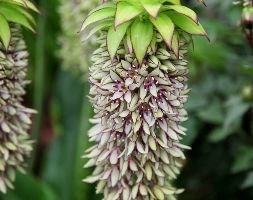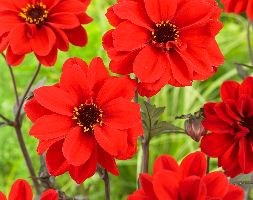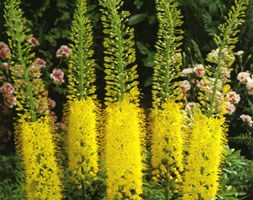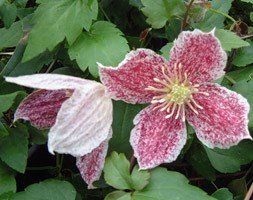Price reductions at Crocus
by Sarah - February 18th, 2014.Filed under: Crocus, Price Reductions.
Crocus reduced the price on these lines today
Eucomis bicolor (pineapple lily bulbs) was £3.99 now £1.99
Position: full sun Soil: fertile, well-drained soil (or loam-based potting compost with sharp sand or grit for container-grown specimens) Rate of growth: average Flowering period: July and August Hardiness: borderline hardy (may need winter protection) A spectacular plant, with spikes of purple-edged, pale green star-shaped flowers on purple-spotted stems in July and August, topped with a pineapple-like tuft a bove a rosette of wide, fleshy leaves. This distinctive, summer-flowering bulb looks stunning planted in clumps in a large, well-drained container or in a sun ny, exotic-style garden. Since it’s not fully hardy in frost-prone areas, it’s best over-wintered indoors in a cool greenhouse. Garden care: Plant bulbs 12cm deep as soon as possible, allowing 20cm between each. In colder areas, provide some protection until the worst of the frosts have passed. Water freely during the growing season and sparingly during winter. Protect the crown of the plant with a dry winter mulch or over-winter indoors under glass. Top-dress or re-pot container- grown specimens each spring.
Dahlia ‘Bishop of Llandaff’ (dahlia bulb) was £3.49 now £1.99
Position: full sun Soil: fertile, humus-rich soil Rate of growth: average Flowering period: July to September Flower colour: bright vermilion-red Other features: excellent cut-flowers Hardiness: half hardy (may need winter protection) Striking, semi-double, bright vermilion-red flowers appear from July to September above the deeply divided, dark bronze-red leaves. This popular, peony-flowered dahlia requires a sunny site with fertile, humus-rich soil. Perfect for a planting scheme based on ‘hot’ colours, the tubers must be lifted and over-wintered in a frost-free place in all but the warmest areas. Garden care: Dahlia tubers can be planted outside after frost, or started off in pots under glass in late winter to early spring. Plant them horizontally approximately 12cm deep, making sure the ‘eyes’ are uppermost. Allow enough room between each tuber so the plants can grow and spread to their full size without being over-crowded. While in growth, provide a high-nitrogen liquid feed each week in June, then a high-potash fertiliser each week from July to September. Stake with canes or brushwood if it becomes necessary. In mild areas, leave them in situ over winter, but protect the crown with a generous layer of dry mulch. In colder areas, carefully lift and clean the tubers once the first frosts have blackened the foliage and allow them to dry naturally indoors. Then place the dry tubers in a shallow tray, just covered with slightly moist potting compost, sand or vermiculite and store in a frost-free place until planting out again.
Eremurus stenophyllus (foxtail lily bulbs) was £6.99 now £3.49
Position: full sun Soil: fertile, sandy, well-drained soil Rate of growth: average Flowering period: June and July Flower colour: dark yellow Other features: strap shaped, bluish green leaves Hardiness: fully hardy Soaring, slender spikes of dark yellow flowers in early and midsummer rising above strap shaped, bluish-green leaves. This spectacular foxtail lily is perfect for creating a bold statement in a sunny, well-drained border. The yellow flowers open from the base of the spike and darken as they age, creating a two-tone effect. It’s best partnered with other late spring flowering perennials and tall grasses which help to mask the plant’s short lived foliage. Foxtail lilies need to be planted in fertile but well-drained soil with the crown not far below soil level. They start to grow in late winter and spring, gathering their strength before they produce their towering flower spikes in summer. Each flower spike has hundreds of flowers which open from the bottom upwards, creating a stunning effect. They thrive in the sunniest spot in the garden, especially if the base of the plant isn’t shaded as this can decrease the number of flowering spikes produced. Garden care: In September every three to five years carefully lift and divide congested clumps. Replant the strongest crown on a layer of sharp grit, spreading out the roots and covering them with a thin (5cm/2in) layer of soil. In frost-prone areas cover with a dry mulch of fern leaves.
Clematis cirrhosa var. purpurascens ‘Freckles’ (clematis (group 1)) was £3.99 now £3.49
Position: full sun or partial shade Soil: fertile, well-drained, neutral soil Rate of growth: average to fast-growing Flowering period: December to February Flower colour: cream Other features: evergreen Hardiness: frost hardy (needs winter protection) Scented, bell-like, cream winter flowers heavily speckled inside with reddish-brown ‘freckles’ and glossy, dark-green leaves. This evergreen clematis is ideal for training over a sunny pergola or arch. This is the best way to appreciate the distinctive freckle-like markings, which are less visible when the plant is grown against a wall. Garden care: No routine pruning is necessary. If the spread of the plant needs to be restricted prune immediately after flowering, cutting back overlong shoots to healthy buds. Apply a slow-release balanced fertiliser and a mulch of well-rotted garden compost around the base of the plant in early spring.
Gladiolus mixed colours (gladioli bulbs) was £5.99 now £3.99
Position: full sun to partial shade Soil: fertile, well-drained Rate of growth: average Flowering period: July to September Other Features: excellent as cut flowers Hardiness: half hardy Bulb Size: 8-10cm This is a mixture of the best large flowering gladioli, ranging in colour from white through to startling red. The flowers are produced from July to September and make excellent cut-flowers. They look stunning planted in groups among shrubs and large herbaceous flowers in a border. Garden care: Plant corms 10-16cm (4-6in) deep in spring, on a bed of sharp sand to aid drainage. In frost-prone areas, lift them when the leaves turn yellow-brown, dip the corms in fungicide and store in a dry, frost-free place over winter.











